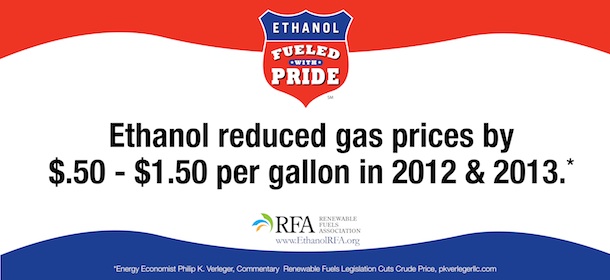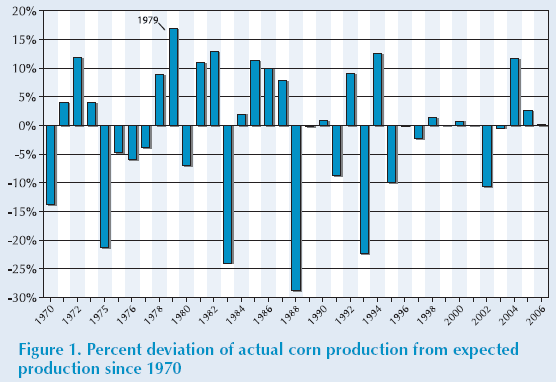It has been a banner couple of weeks for the ethanol industry. To my inbox come their daily proclamations and jubilations over a reprieve they have been given in a recent US EPA analysis of GHG impacts of the fuel. Corn-based fuels from new plants had to reach a minimum of 20% GHG reductions relative to gasoline in order to qualify as renewable under the renewable fuel standard mandates. This reduction, by statute, had to include indirect land use, an effort to recognize that a large surge of land under fuel production would result in loss of carbon sequestering vegetation elsewhere.
While the 20% threshold is the lowest GHG hurdle for a biofuel offered within the mandates, corn ethanol rose to the challenge. While it may seem unbelievable, the analysts at EPA found that not only did corn ethanol reduce GHG emissions by the required 20 percent under certain conditions, but that new plants would provide not a 20.25% reduction; not even a 20.5% reduction; but a whopping 21% reduction. Amazing, just amazing, how the framers of the original requirements were able to predict the outcome of this complicated analysis so accurately.
Indirect land use as bunk
Today, lobbyist C. Boyden Gray argues in the Washington Times that the entire idea of indirect land use, "including as far away as Southeast Asia or Brazil," being considered when assessing the impact of biofuels production is just "flat wrong." His article is titled "Getting a true measure on biofuels," though I assume he is using the word "true" in a lobbyist sort of way rather than its traditional meaning.
He argues in the article that including any evaluation of indirect land use impacts from US fuel production is simply "too difficult" to include. And, I suppose, if something is difficult to assess easily, the only "true" measure is simply to exclude it entirely-- though only for accuracy of course.
Technical difficulties in the write-up (more on this below) aside, the Renewable Fuels Association media machine jubilantly delivered me a link to the Gray piece, so here are my thoughts.
Some initial reactions to the politics of all this. First, I think that any newspaper that publishes an opinion piece from a lobbyist ought to note at the bottom of the article whether the author is actually working for the industry he or she is opining about. I suspect this is likely for C. Boyden Gray and Associates (despite this article from 1990 where Gray seems to be irked by pressure from the ethanol lobby), but it ought to be stated in black and white.
Second, it's a bit laughable to see Gray refering to Tim Searchinger et al.'s article on indirect land use change as causing a "policy imbalance" -- noting that that "Fortunately, there has been positive action on the congressional front to redress the policy imbalance Mr. Searchinger's article has caused." So, let's get this claim straight: Searchinger and his team of academics created a "policy imbalance" by publishing a peer-reviewed article in one of the most respected academic journals in the world, against which one of the most powerful lobby forces in the world -- apparently represented by Boyden himself -- is only now making right? Uh huh.
Life cycle mapping: complicated, inefficient, and probably biased
Enough with Gray's posturing. What about his arguments? I actually agree with some of the concerns he raises on life cycle mapping -- albeit expecting bias in the opposite direction. It is absolutely true that mapping the life cycle impacts of fuel chains is complicated, sensitive to the assumptions one makes, and subject to a wide range of technical problems as one tries to compress what is really a wide range of values for the same crop (depending, for example, on the specific location, fuels used in processing, the amount of irrigation and fertilizers needed, etc.) into a point estimate. EPA's own magical 21% reduction value relies on a variety of these assumptions, including crop yields and co-product credits, well described in this Forbes article by Jonathan Fahey.
The estimation challenges are serious. But they can as easily underestimate climate impacts as overestimate them as Gray implies. In fact, it is reasonable to expect that when complicated, non-transparent modeling efforts are conducted outside of the public purview, they are much more likely to be influenced to support the politically well-connected than the politically weak. The weak, after all, have much smaller budgets. Stated in a more ethanol-specific way: given the same set of scientific facts and uncertainty, and a 20% GHG reduction threshold for corn ethanol to partake in a large subsidy program, it is much more likely that the outcome will hit reductions of 21% than of 19%.
In addition, the analytic intensity (and cost) of the calculations these models require mean the information set driving regulations is subject to wide ranging accuracy problems simply from the long time delays between when information is collected and updated; by modeling staff turnover and its associated loss of specific knowledge; and by a general inability to capture complex systems with available modeling tools.
The result? A detailed round of policy analysis will be repeated only infrequently. Rules may not be properly updated to integrate adverse effects on the ground that were missed the first time around. Errors in who makes the initial cut will be canonized through the grandfathering provisions of the RFA. These lock in facility eligibility under the RFS for life once a plant has passed the GHG test once. Since the purpose of grandfathering is to avoid the premature obsolescence of capital, a far more logical grandfathering period would be limited to the depreciation period of the investment. Efforts to provide this reasonable fix to the existing rules failed.
Carbon taxes, which achieve the same endpoints but in a much simpler, more neutral manner, should be preferred over the options now being pursued most heavily: low carbon fuel standards or emissions trading schemes with difficult-to-validate or distortionary offset rules. Yet, because the taxes offer far fewer opportunities for political barter and favoritism, policy momentum will not favor the simpler solution.
Land use might not matter if biofuels didn't need land
Gray's basic claim -- that land use displacement doesn't matter -- is just plain silly. If land is a finite factor of production (which it clearly is), and there is a sharp increase in demand pressure on that resource, there are only a handful of things that can happen. You can increase the productivity of that land (likely to happen, but not as much as boosters claim, and also with some environmental impacts from soil loss, and increased fertilization and irrigation); your can drive prices up so high that other products not requiring so much land per Btu of energy become more competitive (like oil, perhaps); or you can pull land from other uses into biofuels.
Searchinger talks about international impacts of land use change, and these do partly consist of a loss of forest cover. Gray's counter-argument focuses only on the US, only on forest cover trends, and only for a period (ending in 2005) that preceded the spike in oil and corn prices, and much of the rapid growth in mandated biofuel consumption. In fact, short-term impacts are far more likely to be seen in Conservation Reserve Program enrollment (declined during the high price surges), crop rotations (corn/soy rotations ramped down on the soy), and crop substitution (overall corn acreage was up). Longer-term impacts -- which I suspect we have yet to see in the US, though already evident in Indonesia -- may well cut into forest cover. In fact, given the rising subsidies to cellulosic production from forest wastes; and for direct burning of biomass for electricity, declining forest cover in the US seems all but inevitable.
What about the Iowa State CARD study by Jerome Dumortier et al. that Gray cites to discredit the Searchinger team? This study, "Sensitivity of Carbon Emission Estimates from Indirect Land Use Change," from July 2009, doesn't actually support Gray's claims so far as I can see. Far from concluding that the Searchinger team is "flat wrong," the authors substantiate the general principle of land use impacts and a "carbon debt" where the land conversion impacts create a carbon hole that can take many years of fuel usage relative to a gasoline baseline to "pay off." Specifically, they note that:
"We find that the payback period of corn ethanol’s carbon debt is sensitive to assumptions concerning land conversion and yield growth and can range from 31 to 180 years."
While Gray says the CARD used a "better model," Dumortier et al. note that they calculated a similar carbon debt as the Searchinger team when they used similar assumptions -- that is, the two models produced comparable results. Thus, even if the CARD model is better, the approach used by the Searchinger team is not without merit. One benefit of raising issues like Searchinger did is to encourage investment into improved models.
Only when the Dumortier team changed their assumptions about the impact of biofuels growth on US forest cover and yield growth did the payback period decline to below what the Searchinger team predicted. As Searchinger notes in this reply, uncertainty in how big the carbon debt is does not justify the path C. Boyden Gray recommends of ignoring the issue altogether. In addition, even the lower bound of the carbon debt in the Dumortier study means that corn ethanol will actually worsen the GHG problem during the critical initial response window for GHG stabilization. This is hardly something to celebrate.
Good feed, good food?
Gray also points to the value of the corn ethanol byproducts such as dried distiller's grains in boosting the GHG reduction value of ethanol fuel production, noting that they are a better feed than the corn itself. Again, the issue is not nearly so much in the industry's favor as Gray spins it. Here is Iowa State again, talking about nutritional value:
"However, feeding distillers grains creates some nutrition management challenges, in part because most of the nutrients in corn become three times more concentrated in distillers grains. Nutrients such as sulfur are often added during ethanol production and can occur at even higher concentrations. Formulating rations to accommodate the nutrient composition of distillers grains is further complicated by the significant variation in nutrient content that has been shown to occur between ethanol facilities and even between batches from the same facility. These nutrient issues can limit or even prohibit distillers grains use in some feeding situations."
And this one, from the FDA, on antiobiotic residues in the feed.
Finally, there is increased pressure to take these feed byproducts and use them to boost fuel yield. If more of the DDGs are diverted from feed to fuel, ostensibly EPA should scale down its GHG byproduct credit for corn ethanol. If that change would pull corn ethanol below the 20% magic number though, EPA's revision will likely be a long time coming.





 Back in 2006, biofuel proponents were touting the introduction of ethanol as a boon for domestic energy security. National security was one of the central planks proponents used to advocate for continuing large and growing subsidies to the fuels. The industry continues to highlight the energy security angle. Here is the Renewable Fuels Association on
Back in 2006, biofuel proponents were touting the introduction of ethanol as a boon for domestic energy security. National security was one of the central planks proponents used to advocate for continuing large and growing subsidies to the fuels. The industry continues to highlight the energy security angle. Here is the Renewable Fuels Association on 

